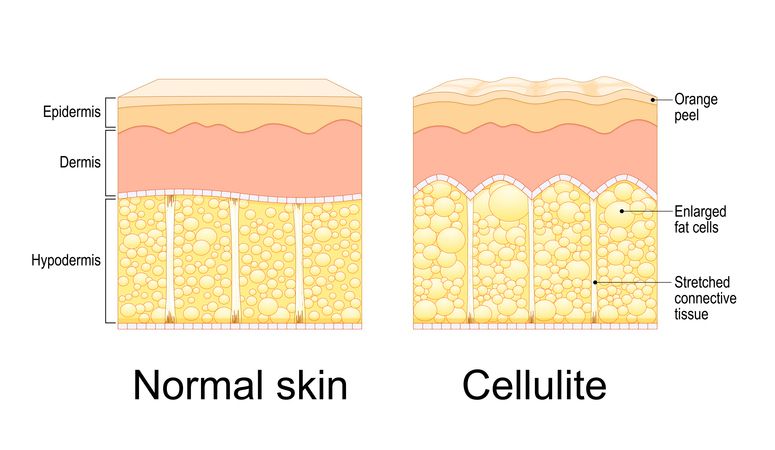Author: Natalie Ng|Updated: 14 May 2025
Acne doesn’t show up randomly. Where you break out on your face can actually say a lot about what’s going on—whether it’s linked to oil production, hormones, or even your hair products. Forehead acne often has to do with excess oil or buildup from styling products. Chin acne? That’s usually tied to hormonal fluctuations. Breakouts on your cheeks or nose might come from clogged pores, oily skin, or bacteria from things like your phone or pillowcase. This idea is known as acne face mapping. It connects different acne zones to possible triggers like hormonal changes, lifestyle habits, or skin conditions. It’s not an exact science, but it can point you in the right direction when figuring out how to treat acne more effectively. Whether you're dealing with persistent acne, fungal acne, or breakouts that flare up around your menstrual cycle, knowing where they show up helps you spot the root cause. Sometimes it's your skincare routine. Other times, it’s diet, stress, or even something like hormonal imbalances. Scroll down to see what each part of your face might be trying to tell you—and how to treat each zone the right way for clearer, healthier skin.

Forehead Acne and T-Zone Breakouts: Causes and Treatments
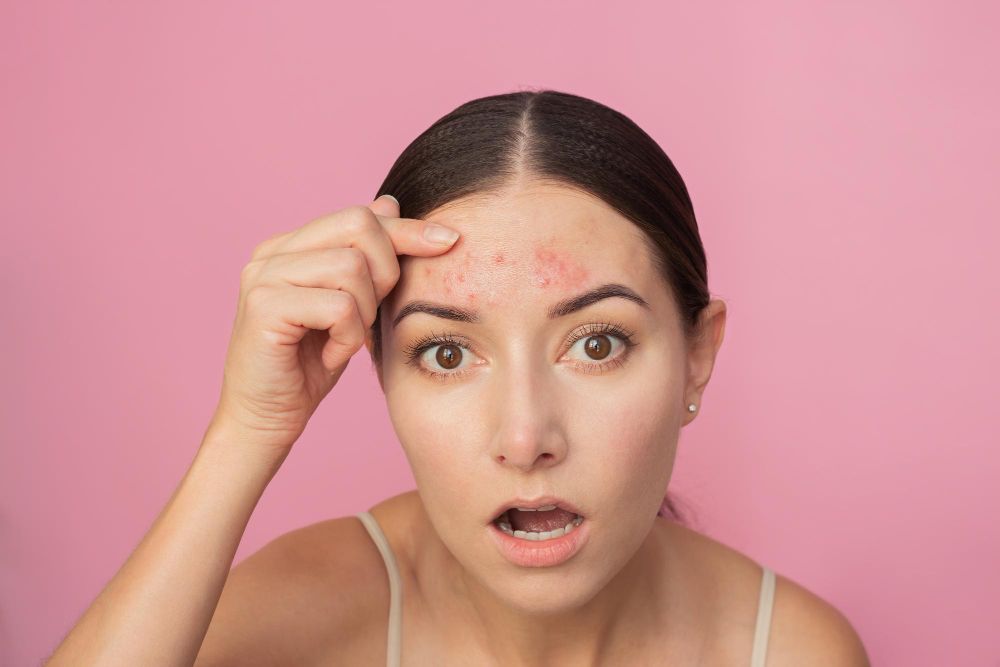
Triggers behind forehead acne
The forehead is part of the T-zone, an area with more active sebaceous glands. These glands produce excess oil, which mixes with dead skin cells and acne-causing bacteria. This buildup can clog pores and lead to comedonal acne or inflammatory breakouts. Hormonal fluctuations often make oil production worse, especially during the menstrual cycle.
Impact of hair and daily habits
Hair products like gels, pomades, and sprays can spread onto your skin and clog pores, especially near the hairline—this leads to pomade acne. Wearing hats, sweating without washing your face after, or regularly touching your forehead can also worsen acne in this area. These small habits increase bacteria, oil, and friction on the skin.
Ingredients that reduce acne and oil
Use a gentle cleanser that won’t strip your skin but still clears away buildup. Salicylic acid helps dissolve dead skin cells and clear blocked pores. Benzoyl peroxide targets acne-causing bacteria. Topical antibiotics can also help in more severe cases.
Ways to prevent forehead breakouts
Keep your hair away from your face. Wash your face after exercise. Choose non comedogenic skincare products and oil-free moisturizers. If forehead acne keeps coming back, check for hormonal imbalances, product buildup, or poor diet. Addressing these root causes can reduce acne and improve overall skin health.

Temple and Hairline Acne: Preventing Breakouts from Hair Products
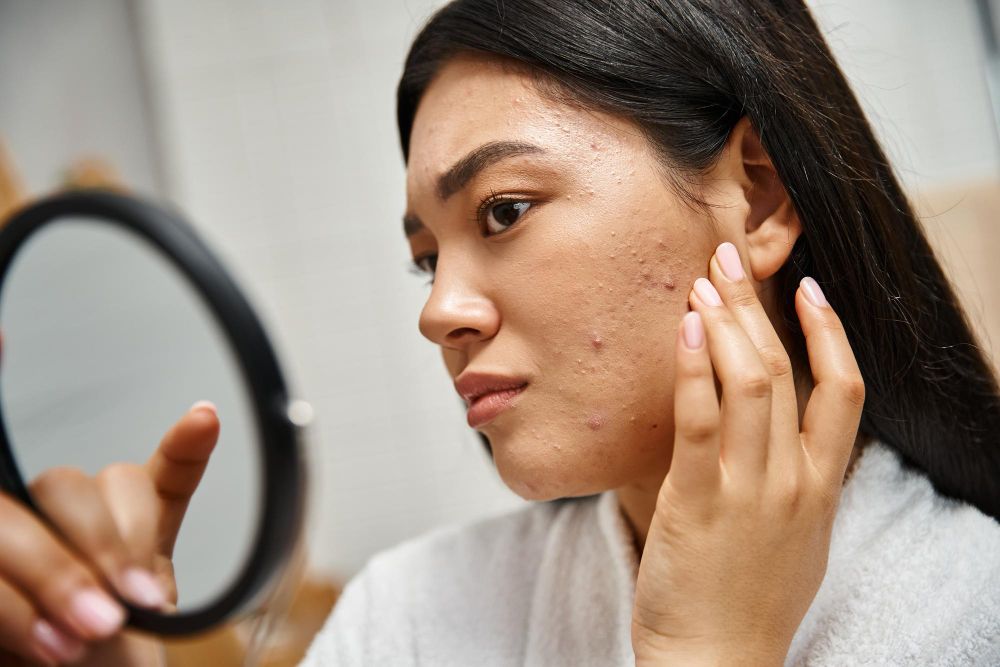
Link between hair products and acne
Hairline and temple acne often comes from product buildup. Ingredients in styling gels, leave-in conditioners, and pomades can clog pores, especially around the edges of the face. This type of acne—commonly called pomade acne—shows up as small bumps or inflamed spots near the hairline.
When these products mix with sweat, dead skin cells, and oil, they form a barrier that traps debris in your pores. This can quickly lead to breakouts, especially if you have oily skin or don’t cleanse these areas thoroughly.
Importance of cleansing around the hairline
To prevent acne around the temples and hairline, focus on daily cleansing habits. Use a gentle cleanser that contains salicylic acid and work it into the skin near your hairline. Rinse well to remove all residue. In the shower, let water run through your scalp and edges to wash away leftover shampoo or conditioner that could clog pores.
After workouts, sweatbands help block hair product from spreading onto your temples. Always cleanse your skin afterward to avoid buildup from sweat and styling residue.
Hair product choices that reduce acne
Switch to non comedogenic and oil-free hair products. Heavy, oil-based products tend to cling to the skin, especially while sleeping or sweating. Look for water-based gels, alcohol-free mousses, or light serums that don’t leave behind residue.
When applying styling products, use a towel or tissue as a barrier between your face and hair. Keep products at least an inch away from your hairline to avoid transfer onto the skin.
Weekly deep pore treatments
Alongside daily cleansing, use a clay mask once a week around the hairline and temples. This helps absorb excess oil, remove buildup, and clear blocked pores. Clay masks with salicylic acid are effective for drawing out trapped oils and reducing acne-causing bacteria in these acne-prone areas.
Finish with a lightweight, oil-free moisturizer to maintain your skin's health without clogging pores. This targeted approach helps prevent acne breakouts in the temple and hairline zone and supports clearer skin over time.
Read More
Book Now to Experience
Acne Treatment
1 Minute Self-Registration
Date should not be before minimal date

Cheek Acne: Reducing Breakouts from Everyday Exposure
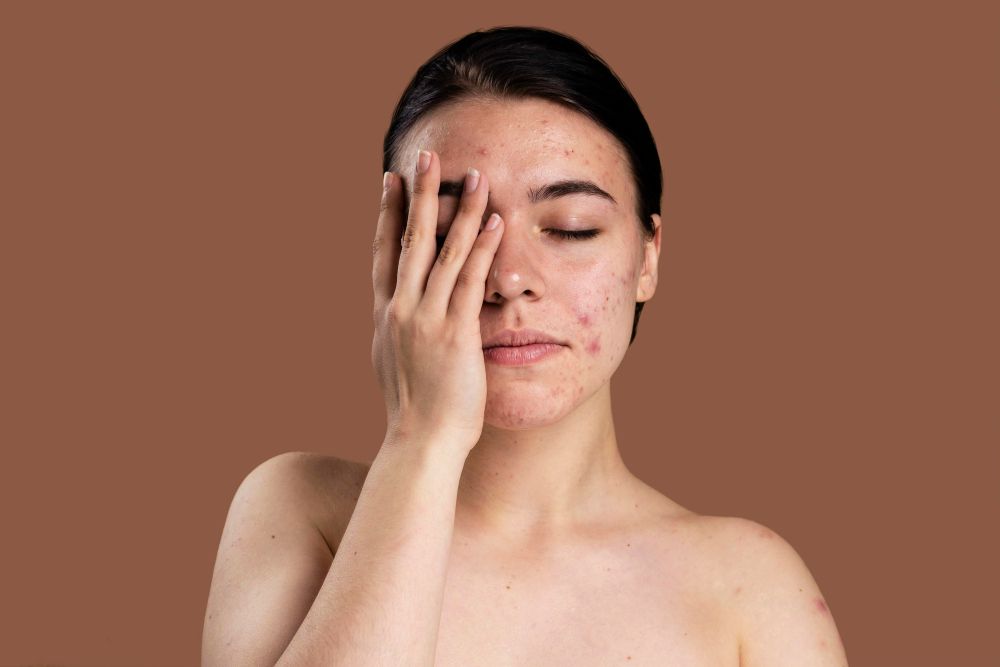
Environmental triggers on the cheeks
Cheek acne often develops due to contact with everyday objects and environmental pollutants. This area is exposed to more surfaces than you might think—your phone screen, pillowcase, hands, and even air pollution can all lead to clogged pores and inflamed skin. Over time, this buildup contributes to persistent acne and can worsen acne if not managed.
Urban environments expose your skin to fine particles and bacteria in the air. These can settle on your cheeks throughout the day, mixing with excess oil and dead skin cells, which increases the chance of pore blockages.
Common habits that worsen cheek acne
Phones pressed to the face during calls can transfer oil and bacteria directly to the skin. Pillowcases that aren’t changed regularly hold on to sweat, dead skin cells, and product residue, which can transfer back to your skin as you sleep.
Touching your face without thinking—especially your cheeks—can also cause acne. Even clean hands can carry oils that clog pores. Shared makeup brushes or unclean applicators add to the problem, introducing acne-causing bacteria to your skin repeatedly.
Routine adjustments that reduce acne
Switch to hypoallergenic detergents for washing pillowcases to avoid irritation from harsh chemicals. Wash pillowcases at least twice a week. Wipe down your phone daily with alcohol-free antibacterial wipes, and avoid touching your face during the day.
Use a gentle cleanser twice a day, followed by a lightweight, non comedogenic moisturizer. Exfoliate once or twice weekly with a mild product containing salicylic acid to remove dead skin cells without over-stripping your skin.
Keep makeup tools clean and stored properly. For acne-prone cheeks, consider mineral-based or non-comedogenic formulas that won’t clog pores or trigger more acne.
Importance of small habit changes
Cheek acne is often caused by a mix of environmental exposure and lifestyle habits. Paying attention to these small daily actions—like cleaning your phone, changing your pillowcase, and avoiding unnecessary face contact—can reduce acne and help support a clearer skin barrier over time.

Nose Acne and T-Zone Oil: Managing Shine and Congestion
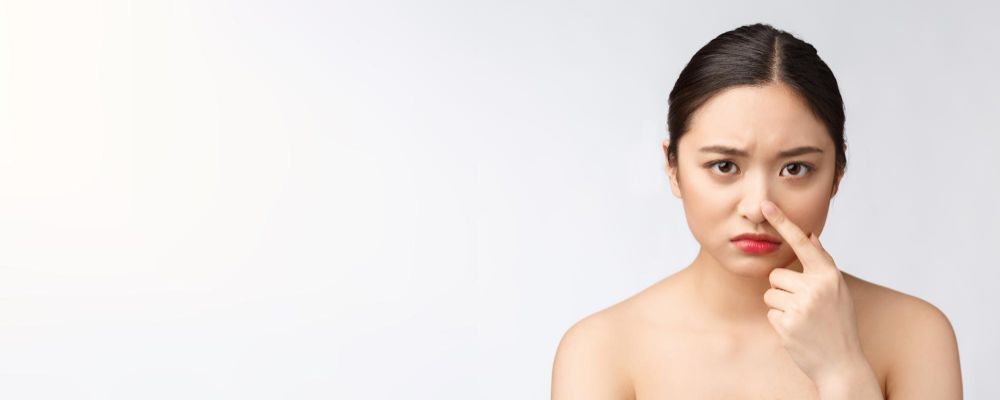
Oil buildup in the nose area
The nose is one of the oiliest parts of the face due to high activity from sebaceous glands. These glands release oil (sebum) to protect the skin, but in this zone, excess oil tends to mix with dead skin cells and clog pores. This leads to blackheads, whiteheads, and more acne breakouts, especially in humid weather or during hormonal fluctuations.
The skin around the nose is also dense with pores, which makes it easier for debris and acne-causing bacteria to settle in, forming comedonal acne or inflamed spots.
Clay masks for deep pore cleansing
Clay masks help draw out impurities from the nose area and reduce oil production. Ingredients like bentonite and kaolin absorb excess sebum and tighten pores without stripping the skin.
Apply clay masks once or twice a week after cleansing. Focus on the nose and nearby areas like the inner cheeks and between the brows. Let the mask dry almost completely before rinsing. This helps reduce shine and prevents buildup that can worsen acne over time.
Targeted spot treatments that control oil
Spot treatments work well for oily patches around the nose. Look for lightweight, fast-absorbing formulas that won’t clog pores. Salicylic acid clears out debris inside the pore, while niacinamide helps balance oil production. Powder-based treatments or silica-infused gels are useful for creating a smooth, matte finish without drying out your skin.
Apply a small amount around the sides of your nose and avoid the nostril area, which can be more sensitive.
Daily habits that prevent buildup
Use an oil-free cleanser morning and night to reduce excess oil without damaging the skin barrier. Blotting papers are helpful throughout the day—press them gently on the nose instead of rubbing to avoid irritating the skin or triggering more oil.
Keep your phone clean and avoid resting your hand on your face. Both habits transfer bacteria and can make acne worse in this area. Avoid harsh scrubs, which can irritate and overstimulate oil glands.
Maintaining clear pores around the nose relies on small daily habits, targeted topical treatments, and weekly deep cleansing—this helps reduce acne and keeps oily skin in check.
Book Now to Experience
Acne Treatment
1 Minute Self-Registration
Date should not be before minimal date

Chin and Jawline Acne: Managing Hormonal Breakouts
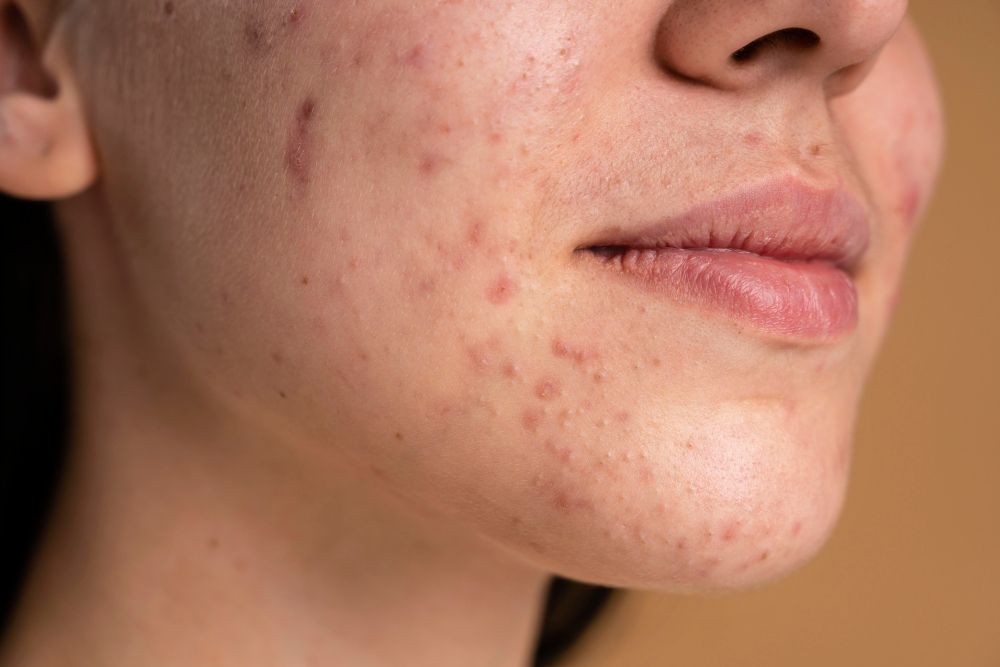
Hormonal impact on chin acne
Breakouts along the chin and jawline are strongly linked to hormonal fluctuations. This type of acne often appears as deep, painful spots and tends to show up in cycles—especially around the menstrual cycle. Androgen hormones can increase oil production, which clogs pores and leads to inflamed, persistent acne in the lower face area.
This pattern of breakouts is common during puberty, pregnancy, or while starting or stopping birth control pills. Hormonal imbalances related to stress or underlying health concerns, such as high blood pressure or polycystic ovary syndrome (PCOS), can also affect this area.
Treatment options for hormonal acne
Start with topical treatments like salicylic acid or benzoyl peroxide to help reduce inflammation and unclog pores. These ingredients are especially helpful when used consistently as part of a daily skincare routine.
For more severe acne or deep cystic breakouts, prescription medications may be needed. A healthcare professional might recommend topical antibiotics, oral retinoids, or hormonal therapy such as birth control pills or anti-androgen medications.
Skincare routine adjustments
Use a gentle cleanser that doesn’t strip your skin. Follow with non comedogenic moisturizers that hydrate without clogging pores. Avoid over-washing, which can irritate the skin and trigger more oil production. Stick to fragrance-free and oil-free products that support your skin’s health without introducing more acne-causing ingredients.
Track your breakouts to see if they follow a pattern. This can help you and your doctor identify triggers linked to hormonal changes or lifestyle factors like stress or poor diet.
Support from lifestyle choices
Eating a balanced diet rich in whole foods, staying hydrated, and getting enough sleep can help reduce acne flare-ups. Limiting processed foods and managing stress also supports more stable hormone levels, which may reduce the severity of breakouts along the chin and jawline.
Chin acne often takes time to improve. A consistent skincare routine and support from a healthcare professional are important for long-term results, especially when acne is triggered by hormonal shifts.

Acne Around the Mouth: Reducing Perioral Breakouts
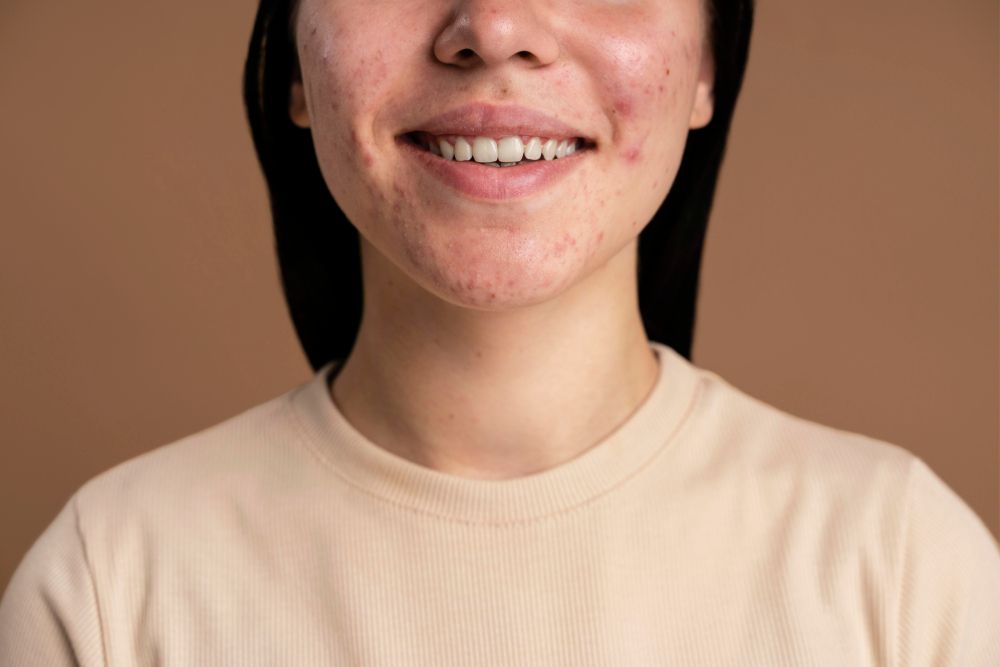
Why acne forms around the mouth
The skin around your mouth is sensitive and easily irritated by everyday products. Toothpaste, lip balm, oily foods, and even certain moisturizers can cause blocked pores in this area. These breakouts tend to be small, clustered, and often feel sore or itchy. This type of acne is commonly referred to as perioral acne.
Frequent contact with hands, food residue, and friction from face masks or tight clothing can also lead to more acne in this zone. If left unaddressed, perioral breakouts can become persistent and harder to treat over time.
Products that trigger acne around the mouth
Toothpastes with strong whitening agents or sodium lauryl sulfate may irritate the skin near the lips. Some lip balms and glosses—especially those with heavy oils or fragrances—can clog pores and worsen acne. Moisturizers or sunscreens not made for acne-prone skin may also be part of the problem.
Switch to fluoride-free or gentler toothpaste formulas, and choose non comedogenic lip care products. Stick to lightweight moisturizers that don’t leave residue near the mouth.
Simple changes to prevent breakouts
Keep the mouth area clean and dry, especially after eating or drinking. Wash your face thoroughly at night using a gentle cleanser that targets oil and bacteria without over-drying the skin.
Avoid applying lip balm or lipstick past your natural lip line, as this spreads product onto the surrounding skin. After applying, blot excess product with a tissue. If you use facial wipes or cleansing balms, be sure to rinse well to remove any leftover residue.
Mild treatments that reduce inflammation
Use a low-strength salicylic acid or benzoyl peroxide spot treatment to reduce clogged pores and inflammation. Apply these only to the affected area, once daily to start, and avoid using multiple acne products at the same time to prevent irritation.
If breakouts continue, consult a healthcare professional. In some cases, perioral breakouts may be linked to conditions like acne cosmetica or even reactions to topical steroids, and may need prescription treatment.
Book Now to Experience
Acne Treatment
1 Minute Self-Registration
Date should not be before minimal date

Internal Health and Acne: Deeper Causes Behind Breakouts
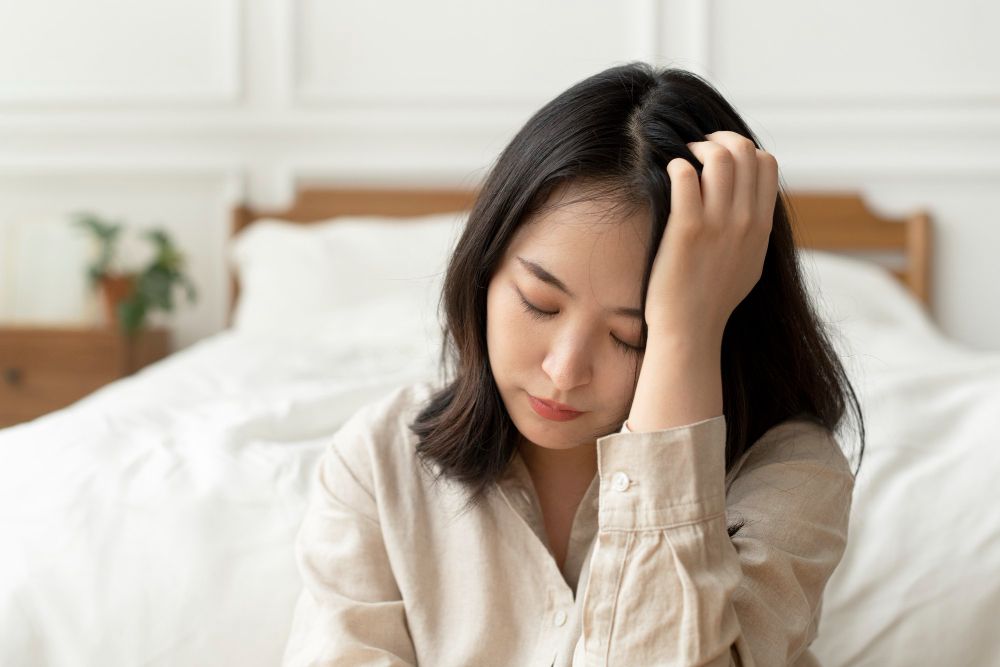
Impact of internal imbalances on acne zones
Face mapping links acne locations to possible internal health issues. While not a clinical diagnosis, it helps identify patterns that go beyond surface triggers. Traditional Chinese medicine connects specific acne zones to organ systems or internal stress points.
• Chin acne is often linked to hormonal changes and menstrual cycle shifts.
• Cheek acne may relate to the respiratory system or sensitivity to allergens.
• Forehead acne can reflect poor digestion, irregular sleep, or high stress levels.
These patterns suggest that deeper, internal triggers may influence why breakouts show up in the same areas again and again.
Importance of diet and hormone balance
Eating large amounts of processed foods, dairy, or sugar may increase insulin and androgen levels, which can stimulate oil glands and clog pores. These changes make hormonal acne worse—especially along the chin, jawline, and lower cheeks.
A balanced diet rich in whole grains, leafy greens, healthy fats, and water helps support the skin’s natural barrier and reduce oil production. Avoiding processed foods can lower inflammation and reduce acne breakouts across multiple areas of the face.
Hormonal fluctuations caused by stress, stopping or starting birth control pills, or conditions like PCOS may trigger persistent acne. Hormonal therapy may be recommended by a healthcare professional if breakouts are deep and painful or worsen during monthly cycles.
Lifestyle choices that support healthier skin
Poor sleep, high stress, and dehydration all affect how the skin behaves. Chronic stress increases cortisol, which can raise oil levels and worsen acne. Skipping rest or not drinking enough water weakens the skin’s barrier and makes it more prone to clogged pores and inflammation.
Support your skin with simple habits: sleep regularly, stay hydrated, eat well, and manage stress levels through daily routines. These changes support your body’s balance, helping reduce acne linked to internal health concerns.

Professional Acne Treatment to Support Face Mapping Strategies
Importance of targeting acne by zone
Acne face mapping helps you identify acne zones and understand the triggers behind breakouts. But skincare alone might not always be enough—especially if you’re dealing with persistent acne, clogged pores, or recurring inflammation across multiple areas like the chin, forehead, or jawline.
That’s where in-clinic acne treatments come in. They complement your skincare routine by clearing buildup deep in the pores, calming oil glands, and improving skin texture across all acne locations. This supports the efforts you’re already making with acne face mapping and helps speed up visible results.
How New Beauty’s Acne Treatment works
The Acne Treatment uses dual spiral suction and drainage to exfoliate dead skin cells, clear blocked pores, and reduce oil production in acne-prone areas. After the cleansing step, a hydrating serum is infused into the skin to calm sebaceous glands and balance sebum secretion—especially useful in oily zones like the T-zone and chin.
This process helps reduce acne-causing bacteria, shrink enlarged pores, and fade acne scars without using injections, oral medications, or invasive tools.
Key benefits of the treatment
• Unclogs pores and removes buildup in areas like the forehead, nose, and jawline where sebaceous glands are most active
• Soothes inflamed breakouts caused by hormonal acne and acne cosmetica
• Hydrates the skin deeply, helping reduce oil production in oily skin zones
• Improves texture around areas affected by acne scars, blackheads, and whitehead
• Supports hormonal acne treatment by calming oil glands without harsh medication
Who it’s suitable for
This non-invasive treatment is ideal for people with moderate to severe acne, acne scars, whiteheads, blackheads, or anyone struggling to treat acne with topical treatments alone. It's also suitable for those with sensitive or dehydrated skin.
Results and maintenance
You can return to normal activities right after the session, and most people begin seeing results with regular monthly treatments. It works well alongside a consistent skincare routine that follows acne face mapping strategies.
Try the Acne Treatment
Support your acne face mapping routine with a clinical-grade solution that clears pores, reduces acne breakouts, and promotes healthier skin across every zone.
Book your free Acne Treatment trial today and take the next step toward clearer skin.
New Beauty's Acne TreatmentBook Now to Experience
Acne Treatment
1 Minute Self-Registration
Date should not be before minimal date
FAQ
1. Can a poor diet cause breakouts in specific acne zones?
Yes, a poor diet—especially one high in processed foods, sugar, or dairy—can influence acne breakouts in targeted areas of the face. For example, a diet that spikes blood sugar may increase androgen hormone levels, leading to excess oil production and clogged pores. Acne face mapping often links cheek and jawline breakouts to digestive health and hormonal imbalances, which are both affected by what you eat. A balanced diet rich in antioxidants, fiber, and hydration may support healthier skin and help reduce acne in multiple zones.
2. What’s the difference between fungal acne and hormonal acne?
Fungal acne is caused by an overgrowth of yeast on the skin, not bacteria. It often appears as small, uniform bumps—usually on the forehead, upper back, or chest—and tends to feel itchy. Hormonal acne, on the other hand, usually appears as deeper, painful cysts along the jawline, chin, or lower cheeks. While hormonal acne is linked to fluctuations in androgen hormones, fungal acne can be triggered by humidity, excessive sweating, or using skincare products that disrupt the skin’s microbiome. Treatment options for each are different, so proper identification is important.
3. Does acne face mapping apply to men’s skin as well?
Yes, acne face mapping can be applied to all genders. While hormonal patterns may differ—especially due to factors like the menstrual cycle or birth control pills—the principles remain the same. Men often experience increased oil production in the T-zone due to androgen hormones, which may result in more blackheads, forehead acne, or nose breakouts. Face mapping can help identify daily habits, skincare product issues, or internal health concerns that may be making acne worse, regardless of gender.
4. Can using the wrong cleanser cause more acne breakouts?
Yes, using a harsh or unsuitable cleanser can disrupt the skin barrier, strip away necessary moisture, and trigger more oil production. This can clog pores and make acne worse—especially in sensitive zones like the cheeks and jawline. It’s important to choose a gentle cleanser that suits your skin type. Look for products labeled as non comedogenic and free of alcohol, fragrances, or strong surfactants that may irritate acne-prone skin. A well-matched cleanser is essential for a consistent skincare routine that helps prevent acne.
5. Are acne treatments safe for people with other skin conditions like eczema or rosacea?
Some acne treatments may aggravate conditions like eczema or rosacea, especially if they contain strong exfoliants or drying agents like benzoyl peroxide. However, non-invasive options like the Acne Treatment—designed to hydrate while clearing blocked pores—may be better suited for sensitive skin types. If you have both acne and another skin condition, it’s best to consult a healthcare professional to create a skincare plan that avoids irritation while treating acne effectively. Always test new products on a small area first to monitor your skin’s reaction.
Recommended Articles
COPYRIGHT© NEW BEAUTY MANAGEMENT LIMITED 2025. ALL RIGHT RESERVED.

